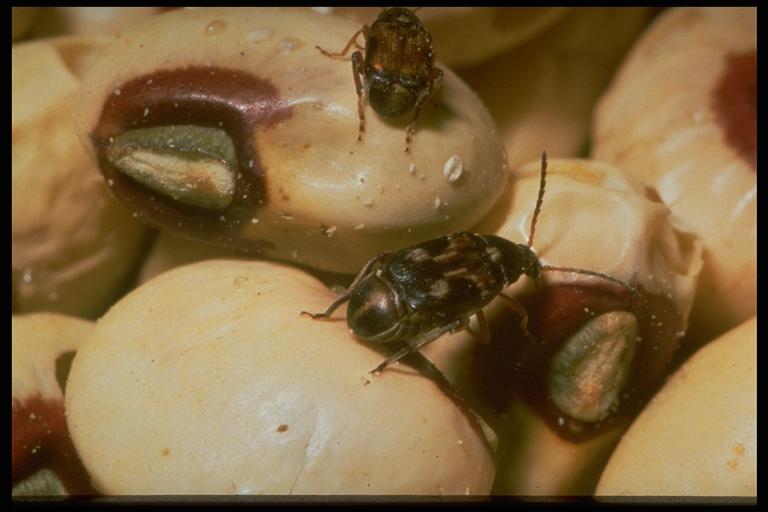
Cowpea weevils, Callosobruchus maculatus (Fabricius) (Coleoptera: Bruchidae). Photo by J. W. Stewart.
Common Name: Cowpea weevils
Scientific Name: Callosobruchus maculatus (Fabricius)
Order: Coleoptera
Description: Adult weevils are 1/8-inch long, reddish-brown slightly elongate beetles compared to the typical rounded appearance of other members of this family (bruchids). Although weevil-like they are not true weevils (Curculionidae) and do not have heads prolonged into a long “snout.” Wing covers (elytra) are marked with black and gray and there are two black spots near the middle (Note: Ebeling says 2 red spots on elytra!). The elytra are short, leaving the last segment of the abdomen exposed. This last abdominal segment also has two black spots visible. The larva is whitish and somewhat C-shaped with a small head.
There are a number of other bruchids including stored product pests and species that attack plants in the wild. Other bruchids that feed on stored products include: the pea weevil, Bruchus pisorum (Linnaeus), which feeds primarily on green peas; the broadbean weevil, B. rufimanus Boheman, which prefers kidney beans and lima beans; and the common bean weevil, Acantoscelides obtectus (Say). Adult bruchids sometimes can be quite common on flowers in the springtime.
Life Cycle: Adults may be found outdoors in flowers in early spring. Eggs laid by females hatch in 5 to 20 days. Larvae typically feed inside the cowpea, taking from 2 weeks to 6 months to develop before pupating there. Six or seven generations may occur per year.
Habitat and Food Source(s): Mouthparts are for chewing. They prefer dried cowpeas but will attack other beans and peas in storage. Adults move about readily and can infest seeds in the field, but can also breed continuously in stored dry cowpeas. Larvae typically develop inside the dried peas. Larvae chew near the surface and leave a thin covering uneaten which appears as a window. Later the adult emerges from the “window.”
Pest Status, Damage: Attacks dried cowpeas and other related stored seeds; medically harmless. Damage appears as round holes in the peas.
For additional information, contact your local Texas A&M AgriLife Extension Service agent or search for other state Extension offices.
Literature: Ebling 1978; Metcalf et al. 1962; Swan & Papp 1972.